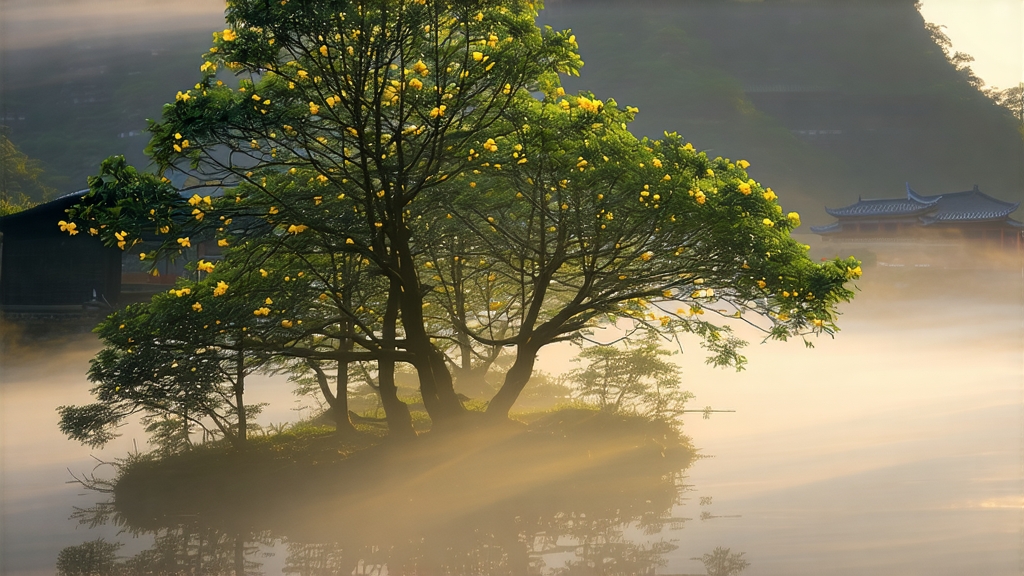
High on Mengding Mountain, where Sichuan’s mist meets the sky, a tea once reserved for emperors still unfurls its secrets one bud at a time. Mengding Huangya—literally “Yellow Bud of Mengding”—is the oldest documented yellow tea, yet it remains the least understood outside China. To encounter it is to taste a vanished court etiquette, a slow alchemy of leaf, moisture and time that turns green into gold without ever touching fire.
History wrapped in legend
Buddhist monks planted the first tea gardens on Mengding as early as 53 BCE, claiming the mountain’s perennial cloud cover was a living dharma robe that sheltered the tender leaf. During the Tang dynasty (618-907) the tea was pressed into cakes and traded along the Tea-Horse Road; by the Song (960-1279) it had become a fiscal currency, paying tribute in silver-weighted tea. The Ming Hongwu Emperor (r. 1368-1398) abolished compressed tea, demanding loose leaf instead. Palace scribes record that the “first spring bud, yellowed and fragrant,” arrived in Nanjing each March guarded by cavalry whose horses wore felt hoof-muffles to keep the road dust from settling on the precious cargo. After 1911 the imperial order collapsed, and Mengding Huangya drifted into obscurity, surviving only through the stubborn memory of a few mountain families who kept one bamboo basket of seed-bearing mother trees untouched by the twentieth-century push toward green-tea modernity.
Micro-terroir on the roof of Sichuan
Mengding rises to 1 456 m where the Sichuan basin meets the Tibetan Plateau. The mountain traps monsoon vapour, creating 220 fog-bound days each year. The short-wave ultraviolet light that filters through this veil slows photosynthesis, forcing the plant to stockpile theanine and aromatic esters. Soils are Devonian quartz sandstone rich in selenium; drainage is sharp, so the roots struggle, concentrating flavour. Only the indigenous Mengding group cultivar—Camellia sinensis var. sinensis ‘Gan-Zao’—has the enzymatic patience to survive the 96-hour “sealed yellowing” process without collapsing into sourness. Every April 5th, after the last frost but before Qingming festival, pickers climb before dawn to harvest the standard “one bud with one unfolded leaf,” no longer than 2.5 cm, still feathered in pale down.
Craft: the invisible kiln
Yellow tea’s identity rests on a step unknown to green, black or oolong: men huang, “sealed yellowing.” After picking, the leaf is spread 3 cm thick on bamboo trays and withered for 90 minutes; mountain wind lowers moisture to 68 %. A quick wok roast—called shaqing—follows, but the temperature is held at 140 °C, 20 °C cooler than green-tea kill-green, intentionally leaving residual enzymes alive. While still warm, the leaf is wrapped in steamed cotton cloth to form a 5 kg “nest.” Inside this micro-kiln, anaerobic respiration continues; chlorophyll breaks into pheophytin, catechins dimerise into theaflavins, and a faint maillard note of toasted rice appears. Every 40 minutes the master unwraps, fluffs, and re-wraps, judging by aroma whether the leaf is “breathing” evenly. After six cycles the leaf colour shifts from jade to old ivory; when a pressed bud snaps cleanly, the yellowing is complete. A final low-temperature bake at 60 °C for two hours locks the colour and raises the fragrance of fresh chestnut.
Grades & leaf code
Mingqian Huangya: picked before Qingming, 100 % buds, needle-shaped, downy, liquor the colour of chardonnay.
Yuqian Huangya: picked before Grain Rain, bud plus first leaf, slightly broader, liquor more golden, aroma of steamed maize.
Summer Huangya: rare, picked in late May, two leaves and a bud, used only for cold-brew; higher catechin content gives a quince-like astringency that mellows after 12 hours in spring water.
Water & fire: brewing as ritual
Western equipment works—yet the leaf rewards restraint. Use 3 g per 150 ml, water at 80 °C, the temperature of a mountain hot spring just cool enough to bathe a newborn